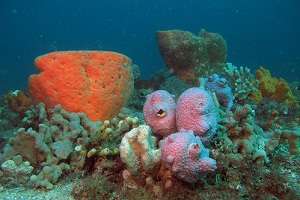Astonishing diversity of western Australian sponge species uncovered with molecular technology

The immense diversity of sponge species in West Australian waters has been celebrated at the 9th World Sponge Conference earlier this month.
Hosted in Fremantle and attended by delegates from 38 different countries, it is the first time the conference has been held on the Indian Ocean seaboard.
Chair of the conference organising committee Dr Nicole Webster says this year's conference covered 'New Frontiers in Sponge Science'.
"With the advent of new molecular technologies we've been able to do things like sequence sponge genomes and uncover a wealth of information that wasn't available before," she says.
"We had a keynote presentation on the actual sponge genome and then a whole range of different student presentations expanding on that.
"They've actually used that genome to look into a range of different areas of sponge biology, evolution and physiology."
She says this year's theme was also particularly relevant for Western Australia.
"WA is really sort of a hub for sponge diversity," she says.
"There's been research effort going into the unique sponge communities that occur in WA in recent years and they're uncovering a massive diversity of previously undiscovered sponge species."
Western Australian Museum marine invertebrates senior curator Dr Jane Fromont says more than 1000 species of sponge have been discovered in WA recently.
"Not all of these are new species," she says.
"But the sponge diversity in WA and the wealth of species that occurs here is truly awesome to behold."
She says this diversity is indicative of the health of WA's marine environment.
She also says there has been an unprecedented interest in providing funding for sponge research.
"The West Australian Marine Science Institute … has industry support to look at the impacts of dredging [on filter feeding communities] in the Pilbara region," she says.
"Our initial survey in March this year found that 70 per cent of all species affected … were sponges.
"It's really important there's been a significant acknowledgement that sponge communities in their own right need to be looked at and research needs to be funded."
She says further important research on the links between climate change, sponges and damage to coral reefs is also being undertaken in WA.
"Some groups of sponges have the ability to bio-erode calcium carbonate, so that's our limestone environments, our limestone reefs," she says.
"Christine Schonberg from UWA has been doing experimental work to monitor whether the incidence of sponge bio-erosion increases with changing climate.
"So this is another instance of globally significant work happening in WA."
Provided by Science Network WA

















